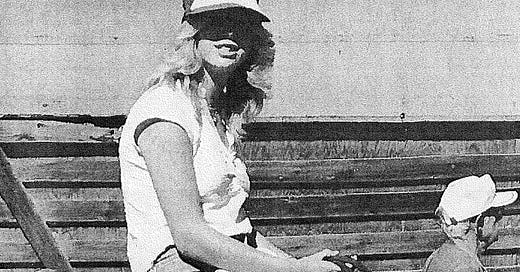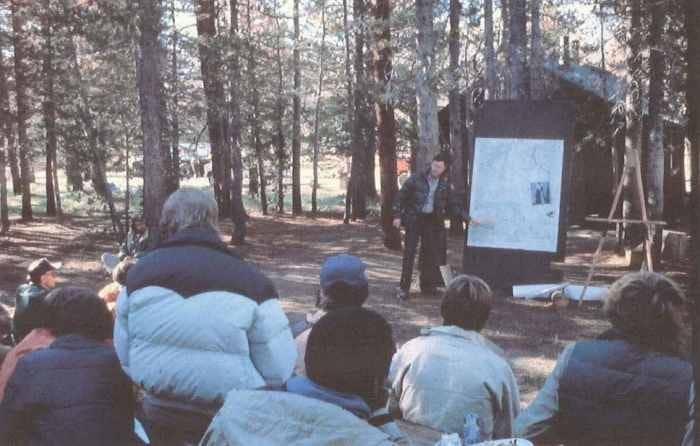Stacy Arras: Teenager Goes Missing in Yosemite National Park
The only trace of her ever found was the lens cap from her camera
Teenager Vanishes from National Park
On July 17th, 1981, Stacy Arras, 14, was horseback riding in Yosemite National Park with her father and six other people. Later that afternoon, they arrived at the Sunrise High Sierra cabins, where they planned to spend the night.
Stacy, who’d been enjoying the day, wasn’t quite ready to go inside yet. She’d brought her Olympus camera with her and wanted to take some scenic shots of the park’s natural beauty. An elderly member of their group, Gerald, offered to accompany her and she accepted.
During their hike, Gerald became tired, needing to take a break, and told the teenager to continue on and that he’d wait there for her. Gerald did wait, for 20–30 minutes, but Stacy never returned. Concerned, he went back to camp and told everyone about what had transpired.
The National Park Service soon organized a large search effort, confident that they’d locate the missing girl quickly. However, the only trace of her they’d ever find was the lens cap from her camera.
What happened to Stacy Arras?
Stacy Ann Arras
One of four children, Stacy Ann Arras was born on September 29th, 1966, to parents George (a building inspector) and Carol. The Arras family resided in Saratoga, California.
Outgoing and outdoorsy, 14-year-old Stacy enjoyed photography, hiking and horseback riding. In late July 1981, she and her father were on a four-day saddle loop trip in California’s Yosemite National Park with six other individuals.
On July 17th, the group spent a few hours horseback riding through Sunrise Meadow, stopping briefly at Upper Cathedral Lake to have lunch. They reached the Sunrise High Sierra Camp at approximately 3 p.m. The camp, built in 1961, had nine cabins and sat at an elevation of 9,600 feet.
“The setting is glorious,” wrote authors Charles R. Farabee and Michael Patrick Ghiglieri in Off the Wall: Death in Yosemite. “It looks over the western edge of a broad meadow dotted with small lakes and ponds, glaciated domes, cliffs, and rocky granite ridges.”
Stacy felt like stretching her legs after spending so much time on the back of a horse. She told her father that she was going to take a walk and asked if he wanted to come along, but he declined. Instead, 77-year-old Gerald Stuart, another member of their group, decided to accompany her.
Stacy told Gerald that she was going to hike over to the Sunrise Lakes—located around 1.5 miles away—and take pictures with her Olympus camera.
Missing
It’s unclear what time they set out, but Gerald became winded during their hike and needed to sit down. He told Stacy that he would wait for her to come back. The two were reportedly still within sight of the group when Stacy walked away, disappearing behind some trees along the trail. She was last spotted standing on a rock and looking off into the distance.
When 20–30 minutes had gone by with no sign of Stacy, Gerald returned to the cabins and told everyone that he didn’t know where she was. They immediately went out looking for her, encountering another group on the trail that Stacy had taken — coming from the direction that she’d been traveling in — but they stated that they hadn’t seen the teenager.
After a fruitless search, George Arras notified the rangers that Stacy was missing.
The National Park Service organized one of the largest searches in the park’s history, which included approximately 150 searchers (67 of whom were from the Mountain Rescue Association), six dog teams, divers, and three helicopters. Over the course of nine days and 8,000 man-hours, they covered a 3–5 square mile area surrounding the Sunrise Lakes.
“Nothing significant found,” said National Park Service ranger Bob Johnson.
Carol Arras didn’t learn of her daughter’s disappearance until two days later.
“They didn’t want me to worry. He (George), the rangers and everyone else thought they would find her in a couple of days.”
However, the only relevant item they recovered in their extensive search was the lens cap from Stacy’s camera. It was discovered near the trail that she was last seen on, next to the tree line. No other clues as to her whereabouts were ever found.
Theories
Yosemite National Park is home to large animals like mountain lions and black bears. Some speculated that Stacy could have been the victim of an animal attack, but no evidence to support this — such as blood or signs of a struggle — was discovered.
Early on, park officials made the vague statement that Stacy was dealing with “school or family problems” and that she missed her boyfriend. Because of this, they considered the possibility that she had exited the park of her own free will, but didn’t think it likely since she’d left in flip-flops, which aren’t the best footwear for a long hike.
Stacy’s father had suggested that she change into boots before taking a walk and some sources indicate that she followed his advice. However, the park’s spokeswoman, Linda Abbott, had this to say when explaining why they didn’t believe that she’d run away:
“If she had planned on walking off, she wouldn’t have gone off in thongs (another name for flip-flops).”
Yet it’s stated elsewhere in the NPS files that she was wearing hiking boots at the time she went missing, so the exact nature of her footwear is unclear.
“Stacy had many friends,” Carol said of her daughter, “but no boyfriend she was missing that much.”
Foul play was also suggested, especially after eyewitness reports came in of an “unkempt young hiker” who was said to be in the same area that Stacy was last spotted. However, the authorities were never able to locate this man for questioning.
Another theory—and the one generally regarded as the most plausible—is that Stacy had gotten lost in the wilderness and succumbed to the elements. Perhaps she’d wandered off the trail and couldn’t find her way back. The temperature reached a low of 40 degrees (F) on the night that she vanished.
Ultimately, in the absence of any substantial clues or evidence, the park service was unable to definitively rule out any theory.
Additional Details
Writer Brent Swancer has claimed that David Paulides—author of the Missing 411 series—filed a Freedom of Information Act (FOIA) request to obtain the files on Stacy’s case and was twice denied.
“You’ll never see it,” a ranger allegedly told Paulides.
Of the 2,000 pages of files on her case, approximately 1% of them have been made public.
“The tough part is not knowing,” said Carol. “You would have thought that some trace of her would have shown up, perhaps her faded blue blouse, a windbreaker… at least something.”
Sadly, George and Carol Arras have both since passed away.
With no further leads or evidence, the circumstances surrounding the disappearance of Stacy Arras remain shrouded in mystery.
Additional Sources
(This article was originally published on HubPages)






